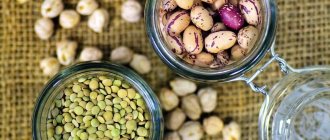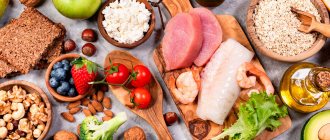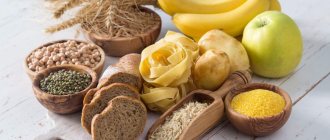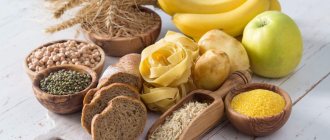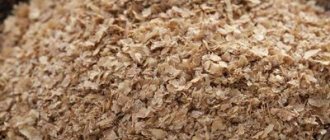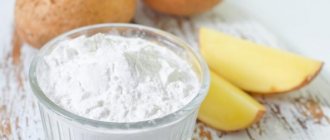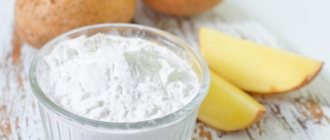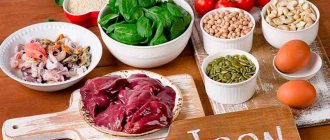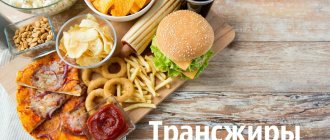Carbohydrates are organic compounds of plant origin, which contain hydrogen, carbon and oxygen. The main function of carbohydrates is to provide the body with energy. They can be compared to fuel for an airplane, without which it will not fly. All carbohydrates are broken down to the simplest element - glucose, which enters all cells and is burned, forming water, carbon dioxide and energy. This energy is needed for processes such as breathing, digestion, thinking, and physical activity. Which foods have more carbohydrates?
What types of carbohydrates are there?
Carbohydrates are divided into:
- Simple - monosaccharides: galactose, glucose and fructose and disaccharides: lactose, sucrose and maltose. They have a sweet taste. They consist of only one molecule, so they dissolve and are absorbed almost instantly when entering the body. Then insulin lowers the rapidly rising blood glucose level, and the brain again demands a new portion of carbohydrates; the feeling of hunger returns. When consumed in large quantities, they promote the formation of fat cells.
- Complex - polysaccharides: glycogen, pectin, starch, fiber. Poorly soluble in water. They take much longer to digest and do not cause a sharp rise in glucose levels, unlike simple carbohydrates, so they provide a long-lasting feeling of satiety. Do not contribute to the formation of fat reserves.
Type of carbohydrates
Which foods have more carbohydrates? These are those products that contain a lot of refined sugar.
Low-carb diet: an overview of the benefits and how it works
Plenty of research shows that for those who make consistent efforts, a low-carb diet is highly beneficial. It's not always necessary to give up all unprocessed, whole sources of carbohydrates (such as the fruits and starchy vegetables mentioned above), but cutting out processed foods, sweeteners, and even grains may benefit you in the following ways:
- Faster weight loss and usually easier to maintain a healthy weight. Since glucose from carbohydrates is no longer available as an energy source, the body will use stored fat in the body instead of the fat and protein consumed through food.
- More satiation from food, decreased hunger and cravings (especially carbohydrate-rich foods and sweets).
- Normalization of blood sugar levels. This is due to better control of insulin and glucose spikes. For a pre-diabetic or diabetic condition, this may be the difference between preventing symptoms or avoiding complications.
- Neuroprotective effects, improved cognitive performance, including reduced brain fog or lack of energy, improved memory later in life, and relief of symptoms of epilepsy.
- In some cases - improved hormonal balance. This often results in improved sleep, less fatigue, relief from pain or muscle weakness, and improved overall tone.
- Reduces bone loss and the risk of developing osteoporosis.
- For athletes, this provides possible beneficial changes in weight and physique, as well as an increase in the relative values of maximum oxygen uptake (VO2 max) and oxygen uptake at lactate threshold (VO2 LT).
- In some cases, the risk of cardiovascular disease or metabolic syndrome is reduced by normalizing blood sugar and bad cholesterol levels.
Wondering what types of foods you should really avoid if you're following a low-carb diet? They're higher in things like sweeteners, flours, and thickeners, so cutting them out will help keep your carb intake low:
- If you want to eat truly low-carb, avoid grains (including wheat, barley, oats, rice and other whole grains). This also applies to all products made from grain flour, such as bread, cakes, cookies, chips, cereals, muffins, pasta, etc.
- Sugar and products containing artificial sweeteners or added sugar (honey, cane sugar, coconut sugar, etc.)
- Most store-bought fruits and fruit juices (with the exception of lime and lemon juice, these have a lot of added sugar)
- Most prepared seasonings, sauces or packet mixes typically contain sugar.
- Alcohol, soda and other sweetened drinks.
- If you want to completely cut out carbs (if you're on, say, a ketogenic diet), also avoid most dairy products, such as yogurt, ricotta, or cottage cheese. High-fat, low-carb cheeses are often included in low-carb diets because they contain very few carbohydrates.
Remember that no matter how many carbohydrates you plan to consume per day, it is helpful to be intentional about consuming more natural foods and fewer processed foods.
It’s best to experiment with an extremely low-carbohydrate diet for a certain period of time, but in the long term (based on how you plan to eat forever), keep in mind that you need to eat a variety of plant foods that contain at least some amount of carbohydrates.
To maintain a long-term therapeutic diet, you need to really understand how many carbohydrates per day, given a balanced diet, you can consume without the risk of gaining weight or developing other health problems. You should use this information about your personal individual biochemistry to help you maintain a balanced diet—one that includes healthy proteins and fats, as well as fresh vegetables, fruits, and even starchy vegetables, legumes, or grains if they suit you.
Daily carbohydrate intake
Normally, proteins, fats and carbohydrates should be in a ratio of 1:1:4. It is recommended to structure your diet so that simple carbohydrates make up 30% and complex carbohydrates – 70%.
The amount of carbohydrates varies depending on gender, age, physical activity and other factors. The greater the level of physical activity of a person and the younger his age, the more carbohydrates are required.
The carbohydrate limit for men ranges from 350 to 580 g, and for women – from 280 to 460 g.
Those who are on a diet are advised to reduce the amount of carbohydrates to 100 g. Those who are actively involved in sports need to consume a large amount of carbohydrates, because their lack will negatively affect the condition of the muscles. The person will become more tired and will not be able to exercise for a long time. It is best to choose complex carbohydrates.
Examples of Low Carb Meals
Breakfast
Country Eggs
Nutrition Facts Per Serving:
- 151 calories
- 46.8 g protein
- 10.4 g fat
- 1.7 g sugar
Try a hearty breakfast dish: Mexican-style country eggs. This dish includes ground meat, eggs, peppers and spices, served on a tortilla with fresh tomatoes, avocado and cilantro. This low-carb meal will give your day a healthy protein start, keeping you energized and full until lunchtime.
Dinner
Shredded cauliflower
Nutritional Information Per Serving (1 1/3 cups):
- 108 calories
- 9 g protein
- 3 g fat
- 1 g sugar
Shredded cauliflower is a quick and healthy alternative to rice that will become your new favorite lunch item. Chop the cauliflower and place in a blender or food processor to create a crumbly mixture. Add eggs for protein, ghee as a healthier replacement for butter, onions and garlic, and you have a simple, tasty and healthy dish.
Dinner
Salmon with pecans and pesto
Nutritional Information Per Serving:
- 140 calories
- 17 g protein
- 5 g fat
- 2 g sugar
This quick and easy dish takes just 25 minutes to prepare. Salmon with Pecans and Pesto is rich in omega-3 fats and healthy protein, and it's an amazing dish you'll want to come back for. To complete the picture, serve it with a salad of leafy greens.
You can also look at the menu for a low-carbohydrate diet, but it is more suitable for professional athletes drying their bodies before competitions.
Benefits of carbohydrates
As already mentioned, the main purpose of carbohydrates is to replenish energy reserves in the body. It is carbohydrates that supply about 50-60% of energy. But this is not the only useful property.
They are needed for the normal functioning of the cardiovascular, digestive, nervous system, liver, brain (it consumes about 70% of energy), providing the required amount of sugar, and removing harmful substances.
Fiber normalizes cholesterol levels and maintains intestinal tone, improves peristalsis. In addition, they take part in the synthesis of certain molecules, regulate metabolism, and participate in maintaining immunity.
Who is it suitable for?
A low-carbohydrate diet may be the best approach for losing weight and improving health biomarkers in obese, insulin-resistant, and highly sedentary people.
As mentioned above, a sedentary person does not waste muscle glycogen, so he does not need to worry about replenishing its reserves. All you have to do is supply carbohydrates for the brain and central nervous system. Usually 100-125 g is enough. carbohydrates per day (this is not the weight of cereals/vegetables/bread, but the carbohydrates they contain). This has a good effect on mental abilities, overall energy and mood.
You can get this many carbohydrates from virtually unlimited vegetables (except starchy ones), 1-3 servings of fruit, and one fist-sized serving of cooked grains per day. Those. you understand, a complete no-carb diet is not suitable for anyone !
It is no coincidence that a meta-analysis of about 50 studies compared 11 popular diets, which can be grouped: low-carbohydrate (Atkins, South Beach, Zone), low-fat (Ornish, Rosemary Conley), balanced (Jenny Craig, Nutrisystem, Weight Watchers), and free food, proved that...
Absolutely any diet for weight loss is better than no diet!
After six months, people on low-carb diets lost more weight. But the overall difference in weight loss (differences in performance) among all diets is insignificant: a few pounds. For example, on low-carbohydrate diets for 6 months, the average losses are 8.73 kg and 7.25 kg in 12 months, versus 7.99 kg in 6 months and 7.27 kg in 12 months on low-fat diets.
Products containing harmful carbohydrates
Harmful carbohydrates
These include:
- bread and other flour products;
- drinks with high sugar content;
- sweets, milk chocolate, cakes;
- various jams and preserves;
- alcohol;
- ice cream;
- fast food;
- White rice;
- some cereals, for example semolina;
- instant food products;
- cornflakes;
- sugar;
- some fried foods;
- popcorn.
Low-carb menu for the week (with recipes)
A low-carbohydrate diet implies a completely varied and nutritious diet. There is no need to completely eliminate carbohydrates. Otherwise, you may feel unwell the next day. The ideal option is to consume carbohydrates in acceptable dosages. However, you need to come to them gradually. There should not be any sudden changes in eating habits. Those who want to quickly (albeit briefly) lose weight are advised to create a menu for the week in advance.
Monday
Breakfast: oatmeal porridge, one apple, coffee or tea without sugar.
Second breakfast: 150 grams of kefir, a handful of nuts.
Lunch: vegetable stew, boiled chicken or turkey breast.
Afternoon snack: low-percentage cottage cheese.
Dinner: steamed fish, vegetable salad.
Tuesday
Breakfast: 2 boiled eggs, hard cheese, fruit smoothie.
Second breakfast: biscuits, natural yogurt.
Lunch: chicken broth, cucumber.
Afternoon snack: orange.
Dinner: stew.
Wednesday
Breakfast: steamed omelette, coffee with low-fat milk.
Second breakfast: a handful of dry fruits.
Lunch: steamed meatballs, broccoli and other vegetables.
Afternoon snack: a small handful of nuts.
Dinner: baked breast, tomato.
Thursday
Breakfast: natural yogurt with berries, green tea.
Second breakfast: a glass of milk.
Lunch: vegetable stew.
Afternoon snack: fermented baked milk (yogurt).
Dinner: light salad.
Friday
Breakfast: oatmeal, unsweetened tea, hard cheese.
Second breakfast: green tea.
Lunch: mushroom soup.
Afternoon snack: low-fat cottage cheese.
Dinner: baked omelette with cabbage and vegetables.
Saturday
Breakfast: chicken breast, 2 eggs, coffee or tea.
Second breakfast: fruit slices.
Lunch: light salad with brown rice.
Afternoon snack: grapefruit.
Dinner: stewed meat.
Sunday
Breakfast: cottage cheese casserole, fruit juice.
Second breakfast: whole grain toast, meat.
Lunch: buckwheat with beef.
Afternoon snack: dried fruit compote.
Dinner: stew with vegetables.
Foods containing healthy carbohydrates
Healthy carbohydrates
This group includes foods with a low glycemic index, which determines the rate of absorption of carbohydrates, and a sufficient content of nutrients:
- fresh vegetables and fruits;
- bran bread;
- meat;
- fish;
- mushrooms;
- Brown rice;
- low-fat dairy products;
- spices;
- nuts.
In addition to carbohydrates, such products contain a sufficient amount of vitamins, organic elements, minerals and other useful and important substances.
Low Carb Table
To lose weight, you need to create a daily menu of low-carb foods.
In this case, you can be guided by a special table of low-carbohydrate foods, the calorie content of which is calculated per 100 grams.
Meat and fish products
| № | Products | Carbohydrates | Squirrels | Fats | Kcal |
| 1 | Beef | 0 | 18,9 | 12,4 | 187 |
| 2 | Veal | 0 | 19,7 | 1,2 | 90 |
| 3 | Chicken | 0,6 | 20,8 | 8,8 | 165 |
| 4 | Pork | 0 | 14,6 | 33 | 355,4 |
| 5 | Turkey meat | 0,8 | 21,6 | 12 | 197 |
| 6 | Chick | 0,4 | 18,7 | 7,8 | 156 |
| 7 | Chicken egg | 0,7 | 12,7 | 11,5 | 157 |
| 8 | Common carp | 0 | 16 | 3,6 | 96 |
| 9 | Cod | — | 17,5 | 0,6 | 75 |
| 10 | Salmon | — | 20,8 | 15,1 | 219 |
| 11 | Pink salmon | — | 21 | 7 | 147 |
| 12 | Pike perch (sula) | — | 19 | 0,8 | 83 |
| 13 | Boiled diet sausage | — | 12,1 | 13,5 | 170 |
| 14 | Boiled doctor's sausage | — | 13,7 | 22,8 | 260 |
| 15 | Low-fat cottage cheese | 1,3 | 16,7 | 9 | 156 |
| 16 | Russian cheese | — | 23,4 | 30 | 363,4 |
| 17 | Kefir 1% fat | 4 | 2,8 | 1 | 40 |
Vegetables
| № | Products | Carbohydrates | Squirrels | Fats | Kcal |
| 1 | Zucchini or zucchini | 5,7 | 0,6 | 0,3 | 27 |
| 2 | Eggplant | 5,5 | 0,6 | 0,1 | 25,3 |
| 3 | White cabbage | 5,4 | 1,8 | — | 28 |
| 4 | Broccoli | 5,2 | 3 | 0,4 | 28 |
| 5 | Cauliflower | 4,9 | 2,5 | — | 29 |
| 6 | Asparagus | 3,2 | 1,9 | 0,1 | 21,3 |
| 7 | Carrot | 7 | 1,3 | 0,1 | 33 |
| 8 | cucumbers | 3 | 0,8 | — | 15 |
| 9 | Ground tomatoes | 4,2 | 0,6 | — | 19 |
| 10 | bell pepper | 5,7 | 1,3 | — | 27 |
| 11 | Radish | 4,1 | 1,2 | — | 20 |
| 12 | Leaf lettuce | 2,2 | 1,5 | — | 14 |
| 13 | Bulb onions | 9,5 | 1,7 | 44,8 | |
| 14 | Pumpkin | 6,5 | 1 | — | 30 |
| 15 | Mushrooms | 1,6 | 3,2 | 0,7 | 25,5 |
| 16 | Celery | 2 | — | — | 8 |
Fruits and berries
| № | Products | Carbohydrates | Squirrels | Fats | Kcal |
| 1 | Apples | 11,3 | 0,4 | — | 46 |
| 2 | Black currant | 8 | 1 | — | 40 |
| 3 | Red currants | 8 | 0,6 | — | 28 |
| 4 | Raspberries | 9 | 0,8 | — | 41 |
| 5 | Blackberry | 7,5 | 0,7 | 0,4 | 35 |
| 6 | Strawberry | 7,5 | 0,8 | 0,4 | 41 |
| 7 | Gooseberry | 9,9 | 0,7 | — | 42,4 |
| 8 | Cranberry | 4,8 | 0,5 | — | 28 |
| 9 | Mandarin | 8,6 | 0,8 | — | 38 |
| 10 | Orange | 8,4 | 0,9 | — | 38 |
| 11 | Grapefruit | 7,3 | 0,9 | — | 32,8 |
| 12 | Blueberry | 8,6 | 1,1 | — | 40 |
| 13 | Cherry | 7,7 | 1 | 0,5 | 34,8 |
To this list of low-carbohydrate products you can add a grain crop such as amaranth (BJU - 8.9 1.7 61.7 kcal - 298). By preparing porridge from it, you can not only get enough, but also improve your health, thanks to the antioxidant effect of squalene, which fights free radicals.
And peanut and almond flour can be added instead of wheat when preparing various desserts.
What can a lack or excess of carbohydrates in the body lead to?
Due to a lack of carbohydrates, metabolism is disrupted. The body begins to replenish energy reserves from proteins, fats or muscle tissue. All this leads to a heavy load on the kidneys and improper salt metabolism.
In addition, due to the breakdown of fats, so-called “acidification” of the body can occur. Chronic deficiency causes glycogen to decrease and fat to accumulate in the liver.
If you severely limit the intake of carbohydrates, then metabolic processes and the functioning of internal organs will be disrupted, a feeling of fatigue, lack of strength, deterioration of cognitive abilities, irritability, and decreased attention will appear.
Apathy, depression, and destruction of important proteins are also possible.
With severe deficiency, the following symptoms appear:
- dizziness;
- headache;
- nausea;
- drowsiness;
- severe weakness;
- hunger.
If you eat food containing sugar, these symptoms disappear.
How many carbohydrates do you need?
But let's get back to carbohydrates. Carbohydrates are our energy. If you lie on the couch all day, then no-carb is perfect for you. But if you are a normal, lively person who also plays sports, then you will be sorely lacking in strength.
The amount of carbohydrates in food is affected by 3 things:
- Activity level. Carbohydrates provide fuel for intense workouts and recovery after them. If they are not spent on anything, they are stored as fat.
Carbohydrates should be looked at as fuel. Unless you exercise and deplete your glycogen stores, you don't need a lot of carbohydrates in your meals. A simple analogy is a car. If it's in a garage, you don't need gas. The tank has a certain volume and anything in excess will simply spill out. In the body, this manifests itself as excess blood glucose, insulin resistance and, ultimately, type II diabetes.
But if you drive your car every day, you should fill it up often. No gas - the car doesn't move. In the body, this manifests itself as a feeling of fatigue, apathy, irritability, depression, impaired performance in training, muscle loss, insomnia, low testosterone levels, impaired production of thyroid hormones, and decreased metabolism.
People often make the following mistake: on a high-carbohydrate diet, they lead a sedentary lifestyle . They try to eat healthy food: they drink fresh juices, eat probiotic yoghurts, low-fat foods and whole grain bread. However, despite this, they gradually gain weight. Health problems begin: blood pressure rises, glucose is higher than normal.
Let's say it again: if you lead a sedentary lifestyle, you don't need a lot of carbohydrates. At rest, the body uses primarily fat for energy (yes, read “Cardio or strength training: the best conditions for burning fat. Energy for muscle work” ).
If you constantly bombard your body with too many carbohydrates that you have nothing to spend on, when you have excess calories, they turn into fat. Even if the source of carbohydrates is a healthy whole grain product.
However, even more people make another mistake: combining a low-carb or no-carb diet with strength training . It’s all clear where this heresy came from: our favorite phytonies were recommended. Drying, a difficult path, overcoming oneself and all that.
Classic strength training, crossfit, interval training, functional and other intense and heavy workouts are not suitable for a low-carb diet. Otherwise, you will work hard, become stronger and more technical, but you will look... uh, well, so-so.
It turns out to be a stupid situation: you can appear in an educational video because you know how to do a bunch of different exercises perfectly and technically, but they will never offer you this because you look like you don’t train at all.
Consequences of giving up carbohydratesTo make matters worse, you have lost your libido, are tired, irritable and restless, have trouble sleeping or suffer from unreasonable depression. If what was written about you, immediately stop choking on protein and increase the amount of carbohydrates in your diet . High-intensity training is a completely different situation with a different set of metabolic, hormonal and physiological norms than a sedentary lifestyle.
Yes, you may have lost weight on such a diet, but! Now you are a completely different person in terms of metabolism . If you do not change in time and continue to eat a diet that does not suit you and your lifestyle now, you will increasingly feel tired and tired, in a bad mood, not sleep at night, get sick often, and possibly get some problems with your hormones and libido.
- Metabolism. If you really obesity (not 5-10 extra kilos), and you plan to lose weight, carbohydrates should definitely be reduced - this is the easiest and safest way to reduce calories. An organism with such problems has poor sensitivity to insulin: it becomes increasingly difficult for it to send glucose to muscle cells, which will be primarily stored as fat.
How does resistance develop? The more carbohydrates a person eats (and does not waste), the more glucose there is in the blood. In response, a lot of insulin is released. With constant strong and frequent bombardment of insulin, muscle cells lose sensitivity and stop accepting glucose.
Lean and muscular people have good insulin sensitivity—it can efficiently supply glucose to muscle cells . Metabolic state may change over time. Once you lose weight, improve your health biomarkers, and build muscle with strength training, the need to severely restrict carbohydrates will pass.
But even an obese person not completely eliminate carbohydrates. He must reduce their quantity and change their quality.
- Lifestyle and personal preferences
The best diet plan is the one you can stick to for a long time. This fact is constantly ignored. If you are used to eating a lot of carbohydrates, then sudden changes will not help you stick to your diet. It's better to do this:
- Increase your protein servings with each meal.
Reduce (but do not eliminate completely) portions of cereals.
- To control calories, reduce fat in your diet.
- And only after you’ve adjusted your diet (a month or two) do strength training as a way to increase the body’s sensitivity to insulin.
Cardio is absolutely not suitable here, it will not solve problems with insulin resistance, in addition, have mercy on your joints from such “pleasure”, to withstand running 100 kilograms, more about this in the article “ I’m afraid to pump up” or why they lose weight in the gym .
Carbohydrate diet
To lose weight, you need to eliminate simple carbohydrates
Unlike other diets that are built on severely restricting the amount of carbohydrates, this diet allows their consumption. Indeed, due to a lack of carbohydrates, performance decreases and general condition worsens.
Of course, the carbohydrate diet, like others, has its own rules:
- eat about 5 times a day;
- each serving is approximately 100 g of food and 150 ml of liquid;
- limit the consumption of simple carbohydrates, use mainly complex carbohydrates;
- limit the consumption of sweets, fried foods, sugary drinks, salt;
- The last meal is no later than 7 pm.
Nuts and seeds
Nuts and seeds will help you cope perfectly with the feeling of hunger:
- Almond;
- Walnut;
- Cashew nuts;
- Hazelnut;
- Sunflower seeds;
- Peanut;
- Flax-seed;
- Coconut flakes;
- Chia seeds;
- Sesame seeds;
- Pumpkin seeds;
- Pistachios.
You can “peck” at these low-carb helpers all day long, forgetting about nutritious food for a long time.
Not everything is as bad as it seems at first glance, because from the above products you can prepare a lot of different dishes and desserts. Once you are full, you can not feel hungry for a long time. But, if you want to eat something sweet, berries and fruits will come to the rescue.

